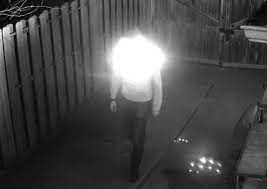CAMERA SHY HOODIE
- Boney Maundu

- Oct 12, 2023
- 3 min read

HOW A CRIMINAL CAN USE A CAMERA SHY HOODIE OR IR LED HAT TO BLIND CCTV SECURITY CAMERAS
What is a ‘camera shy’ hoodie?
Also known as an adversarial IR hoodie, it’s a type of modified or DIY garment that’s designed to make the wearer anonymous before night vision security cameras. It’s a type of privacy wearable garment that includes privacy spectacles, IR LED hats, and other anti-facial recognition make-up.
How does a camera-shy hoodie work?
The hoodie is usually made of embedded high-output IR (infrared) LEDs (light-emitting diodes) commonly used by CCTV security cameras that enable them to capture discernible images in conditions of no or insufficient light, simply known as night vision.
When the IR LEDs on the hoodie are pointed back at the night vision-activated CCTV camera, the camera’s image capture becomes overexposed, thus losing definition of the captured scene. When adversarial infrared light is shined back at the night vision camera, the camera tries to correct for the brightness, resulting in overexposure to the captured scene, particularly around the area where the IR is concentrated.

Privacy IR spectacles, popularly known as ‘reflectacles’, and IR LED hats work the same way. The IR light they emit blinds security night vision cameras at night, ‘whiting’ out the wearer’s face and making it unrecognizable.
The LEDs are arranged around the upper chest area and shoulders or around the hood and powered by a small concealed power source and a switch, ideally around the sleeve. This can be a DIY undertaking with some basic electronics and sewing skills.
All that will be recorded or a viewer will see is a bright haze around the face, obscuring the face and making facial recognition generally impossible.
The hoodie looks innocuous enough to pass off as regular clothing that would not attract any undue attention since infrared light is imperceptible to the human eye and only affects IR-sensitive equipment. Anyone around or watching the wearer will not be able to tell that the IR LEDs are on.
While they might be imperceptible to the naked human eye, a sentry watching security night vision cameras would most definitely be interested in the wearer, who would be walking around with a bright light obscuring the head and face. This makes the wearer even more conspicuous and unable to blend in with the general crowd or traffic. It would be like walking with a bright white target on their head.
It would work in most situations where the cameras are not being actively watched, like in homes, but in high-security facilities where the cameras are under constant monitoring, the wearer becomes a very conspicuous target.
They are also ineffective in sunlight or when there is sufficient lighting that would prevent the camera from kicking into night vision mode.
How a camera-shy hoodie or IR LED hat can be defeated
Adversarial IR garments work at night or in conditions of no light when the CCTV camera’s IR cut filter is off.
Using security cameras with improved IR cut filters can help in cutting out unwanted or adversarial IR light and thus deliver credible images. IR cut filters turn on during the day and help block infrared during the day and only admit visible light, which ensures captured images are credible and a true representation. The filter is off at night and in low-light conditions.
Another option would be to install cameras alongside bright security floodlights. This would help to nullify the threat from such adversarial garments since the IR filter would stay on as it’s technically still as bright as day, according to the camera.
Like most technological inventions that were made with good intentions, there’s no telling how they would later be applied for unethical purposes.
Privacy garments and make-up might have been made by people who were concerned for their privacy, who did not want their faces captured by facial recognition systems, and used for a variety of reasons, like marketing or even stalking.
But they can obviously be a headache for security systems, law enforcement, and people concerned for their security, especially since they’re subtle and don’t require one to physically incapacitate or hack into a security camera.
Tech Contractor / Writer
Nairobi, Kenya










Comments